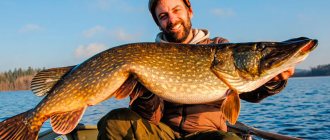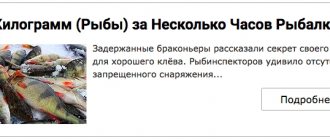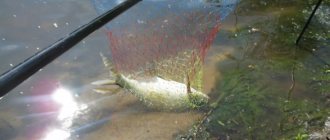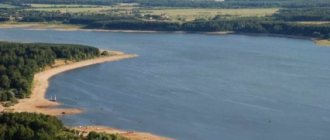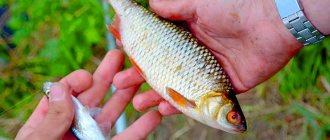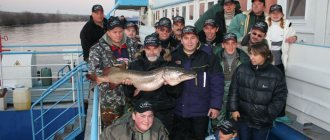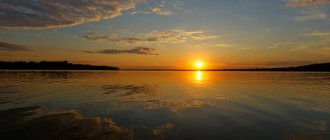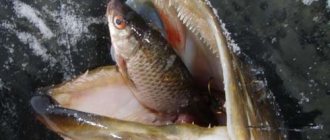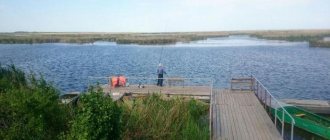In recent years of winter fishing on the Gorky Reservoir, roach has been the most desired trophy for me.
Probably many people are familiar with this body of water. It simply amazes with its vast expanses. And not only that. Every ice fishing season, the Gorky Sea is visited by thousands of fishermen. Even the water area of the Cheboksary Reservoir within the Nizhny Novgorod region does not always attract as many ice fishing enthusiasts as Gore-Sea.
What attracts thousands of winter fishing enthusiasts to the vastness of this reservoir? Mostly perch. The number of striped fish in some years was simply amazing. Any boy could fill a box with 50-70 grams of minke whale.
Of course, this doesn't happen every year. Outbreaks of stable perch bite occur systematically. But even in a good year, you have to be able to catch a normal perch, and filling boxes with finger-sized frozen wood chips has long become uninteresting.
But the sea also has more worthy trophies of labor - this, roach. The sea horned fish is a rather difficult object to catch. This is confirmed even by regulars of the reservoir. Among fishermen, catching a couple of dozen plump sorog was always more honorable than perch of the same size, even in larger quantities.
Finding the flock's resting place and solving the next biting riddle - these are two components of success that must always be kept in mind.
Rivers and sea
Not long ago I decided on the main places to search for roach in the Gorky Sea. The winter season always had to open at the mouth of small rivers, such as Loimina, Micha, Mocha, Kurtyuga, Shomokhta, Trotsa, Yug, Yachmenka, which flow into the sea as a small river with a current. From such bays, formed when river mouths are flooded by a reservoir, ice fishing usually begins and ends. There is an opinion that fish in river bays is caught exclusively on the first ice. First of all, this applies to perch, of course, but also to sorog.
Allegedly, the fish stays in the bays for no more than a couple of weeks from the moment the ice forms, then goes out to sea and enters again only on the very last ice. When the long-awaited moment of first ice finally arrives, everyone scatters around the bay and tries to get as close as possible to the exit to the sea. They are waiting impatiently for when it, dear, will “stand up.” The especially brave ones, not wanting to wait, go out onto the fragile sea ice. Often this ends tragically. Instead of putting in a little effort and finding fish in the river, many people think that “all the salt is in the sea.” There is supposedly more oxygen, food, and space to search.
With perch, such statements are true. In winter, it is caught many times worse in rivers than in the first ice. Apparently, he really leaves the rivers and goes to the sea. Schools of sprat are very demanding on the oxygen content in the water, and in the sea its level is always higher. Therefore, the striped fish has something to strive for in deep water. But roaches don’t need sprat.
The main roach sites and feeding grounds in rivers and the sea are located near snags. This is a truth that should be learned by anyone who is going to this body of water for the first time. Of course, there is room for exceptions, too, but snags are not only the home of predators. Many fishermen living near the sea distinguish sea roach from river roach. It’s quite easy to learn how to do this - the sea fish has a light color of the body and fins, the river fish is darker.
Both morphs are found in river bays, which means only one thing: the fish comes from the sea. And, as I was able to repeatedly confirm from personal experience, she does this throughout the entire under-ice season. The only difference is the number of fish entering the river, which depends on the time of year. Roaches continue to be caught in rivers throughout the winter. In the dead of winter you can sometimes achieve much better results than during the period of first ice, for example. It is easier to look for roach in river bays.
Soroga in the sea - “a hat flying over Paris.” In the morning it is there, but after a couple of hours it will evaporate and will not show itself here again during the day or the next weekend.

Catching roach in the vastness of the sea is an activity reminiscent of a lottery. And moreover, the experience of fishing and the efforts to find it do not always help. To put it simply, a sorog in the sea is in constant motion, the trajectory of which is not always known.
Often it is replaced by the ubiquitous perch, to which many simply switch. Or, in the process of searching for roach with a baitless jig, we inevitably come across a striped one and, as a result, we begin to catch something slightly different from what we are looking for. And in general, catching roach directly in the sea is a very difficult thing. This is a completely different topic of conversation and a more labor-intensive process, for which I am not yet ready to give any theoretical conclusions.
With the roach living in the bays of the rivers of the Gorky Reservoir, everything is much clearer. The so-called “local” roach, for which the river bay itself is its home, adheres to the same habitats. She visits her native snags regularly and goes out to eat from them sooner or later. And there is simply no need for her to go to sea. And the seagrass periodically enters rivers throughout the winter, which many do not even suspect.
Opened the 2021 season. Gore-perches on Gore-Sea.
The goal of our fishing today was to catch perch using spoons and balancers. The fishing location was decided in the evening, and it became a section of the Gorky Reservoir in the area of the Belaya River. Previously, I had the opportunity to catch perch in these places, but exclusively with a spinning rod. It was my first time here as Penguin. Forecasters promised a fairly strong wind of 10-12 m/s and an air temperature of -2 degrees. Didn't deceive...
We arrived at the scene a little before eight in the morning. Although daylight is coming, it is still dark at this time, so we had to wait a little for dawn. We went on the ice at 8:20. At this time, you can already move around the reservoir more confidently than in the dark. We decided to start fishing from a depth of 4.5 m. and a distance from the shore of no more than 200 meters.
The first holes drilled did not bring results either with balance beams or with spinners, and we began to move a little towards the shore, constantly approaching it and then moving away, but at the same time moving along the coastline. Without a device and a camera, the search for fish had to be done in exactly this way. On my next approach to the shore, at a depth of no more than one and a half meters, I got a bite. The result was a small perch no more than 50 grams. Then the second, and the hole “died.” My Father, who was always nearby, was able to catch only one minke whale, after which we went on our search. An hour later it was clearly clear that all the fish were concentrated along the shore with a distance of no more than 100-150 meters from it. This was later confirmed by the location of the fishermen sitting in a line for a kilometer or two. Everyone bit the same - 1.2 perch, drill another hole! The fish had no particular preference. The bite was equally bad on both the spinner and the balance.
The “festival” okushok, unfortunately, there were no trophies.
The total number of fish I caught was no more than a dozen striped fish. It was possible to fish near the shore, of course, where each movement of the balancer is followed by an uncertain poke, and a perch the size of a little finger lands on the hook, but we wanted larger fish, so the result was not impressive.
The largest ones in the photo: one is mine, the other is Bati’s.
By 13:00 the bite had died down and we decided to head home. Thanks to the strong wind, my face will burn like a prohibitory traffic light sign for several days) Overall, the fishing is not bad, and, as we know, there is no such thing as bad! I tested a couple of my budget kits, which I was very pleased with!
Fishing rods: Namazu Pro IGP Perch Edition 50 Lines: Balsax Iguana 0.14mm, Balsax Reventon 0.16mm
No tail, no scales! Don't forget to subscribe to the channel so you don't miss the most heartwarming videos from my fishing trips!) youtube.com/c/SpinningistNN
Nozzle only
It's difficult to say what this is connected with. I assume that with the food supply. A very rare exception occurs when roaches in the waters of the Gorky Reservoir prefer animal baits in the form of bloodworms, maggots, and the like. But, for example, in the bays of the Cheboksary Reservoir, you can catch roach with equal success in two ways: stationary, taking turns going around the baited holes with “baited” tackle, or spend the whole day running with no bait. Both approaches can produce the same results.
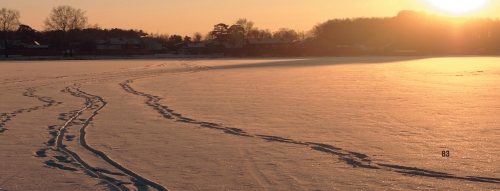
And on Gore-Sea there is no bait and only that! There can be no talk of bait at all. My partners and I sometimes even joke: “If you want to ruin a friend’s fishing, feed the hole next to it...”
In this material, I do not want to impose my preferences on specific types of nozzles. Everyone firmly believes in the catchability of their favorite jig, and this, of course, is the main thing. One can catch well with his favorite “devil”, the other is no worse than the “cobra”, proven over the years.
Fishing Features
In spring and summer:
- perch;
- bream;
- smelt;
- bleak;
- burbot;
- sturgeon;
- whitefish;
- bersha;
- blue;
- saberfish
Autumn and winter:
- roach;
- crucian carp;
- perch;
- sorog.
You can successfully fish both from the shore and from a boat using any gear, especially spinning rods and float rods. Worms, chicken liver, corn, wheat porridge, shellfish, maggots, etc. are excellent baits.
Fishing on the Gorky Sea is free, but on the shores of the reservoir there are a large number of recreation centers where you can get all kinds of services for a certain fee.
In the winter season, fishing in the reservoir is also successful and has a number of features:
- Mostly medium-sized fish are found, weighing up to one kilogram;
- it is necessary to use jigs and special winter fishing rods;
- You should fish in areas of maximum depth;
- the best baits are considered artificial, with a strong aroma, as well as worms;
- Excellent bite is observed among roach, silver bream and perch.
First ice
It is no secret that the first places in the sea to freeze are the mouths of the rivers flowing into it. The bulk of fishermen flocking here are focused on perch fishing during this short period. With a balance beam or a jig, fishermen scatter along the strengthened first ice of the rivers in search of schools of striped fish. And only a few purposefully go after roaches. And by the way, she is not inferior to perch in activity!
In the first ice, in contrast to the last ice, roach stay in small schools. The main thing in their search is to find the snag. It could be a tree lying at the bottom, or maybe just a couple of branches. In unfamiliar places, a good helper in finding snags is a balance beam. This kind of bait looks for hooks on its own, and we need them just in time. Searching for snags with a jig is a process that can take a whole day. Moreover, it is important to find a snag and fish as close as possible to it, and not just know that the snag is nearby.
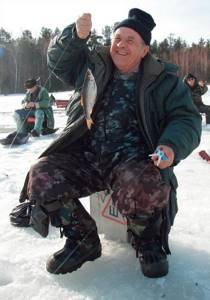
The correctly found hole will be shown by the capture of worthy specimens. As a rule, there are no small perch here. There is no time to waste on a short December day. You should not run to where the “bazaars” gather. It’s easier to find active fish yourself. To do this, it is enough to work well with an ice auger, and your search will definitely be rewarded. Catchy, fresh holes can produce dozens of fish in a row, so “the game is worth the candle.” There is no point in focusing, as I did before, on the hole that brought success. Although she will periodically delight with one or two roaches, the search for a new catching point will be much more effective. Having marked the points in the navigator, in a month you will not have to spend a lot of time and effort searching for them.
February
Unlike many people, I love February. For longer days and mild weather, in contrast to frosty January, for little pressure from anglers. There is no fuss on the ice, you are not being watched with binoculars - everyone has gone out to sea on their heads.
In the morning you sit down on a snag found under the virgin snow that has already been explored in the first ice, and the fishermen going to sea laugh at you as if you were an inexperienced beginner who doesn’t want to go far.
The main thing is not to be exposed in the early morning hours until all the people have gone to sea. Without a navigator or other landmarks, looking for snags in the middle of winter is a problematic task. By this time the ice reaches half a meter thick and, as a rule, also contains water.
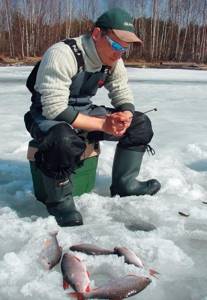
In February, there are not so many perch in the rivers, and those that remain change their autumn habitats. And if previously it was dispersed throughout the entire water area of the bay, now it gravitates more towards the coastal zone and shallow depths. Snags far from the shore are no longer so attractive to him. True, it is often replaced by a small ruff. This is a sure sign that the hole needs to rest.
In February, I use a fairly simple scheme and procedure. This is a one-by-one fishing of promising holes. After fishing in one snag and catching “good” holes from the heels, I go to the next one and do the same thing. So during the day you wander through three or four snags and make several trips to catchable holes. If there is an active roach, then you catch it from the first retrieves; you catch more passive roach by changing the game or type of jig.
On rare occasions in February I had to look for new places. It takes a lot of time and effort, but results are usually not achieved. It is more profitable to sit and shake out inactive roach in already explored places than to spend hours searching for new points and doing the same thing there. Although a fresh place gives an order of magnitude more bites, which are also distinguished by their confidence. But again, this takes time.
Winter fishing
For this period of fishing on the reservoir, there are many wonderful places and places where you can’t get to in the summer even if you wanted to. For example, opposite the place where the Unzha River flows, next to Yuryevets. This place has been known since royal times; fish was caught and delivered to court tables here.
This area is good for fishing because three rivers connect here, and it spreads over 15 kilometers. In summer it is difficult to get to these places due to poor traffic. An excellent place for fishing is near the dam that protects Yuryevets from the spring flood of the Volga. Thanks to the current, the fish feels great and does not suffocate even in the darkest season. The bottom of the dam is covered with multiple sand spits, and with a small current this place is ideal for catching ruffs and roaches. When fishing, they use reelless jigs; in rare cases, they are ineffective.
Local amateur fishermen use dragonfly larvae as bait to hunt for large perch. You can catch it here by positioning yourself on a flooded channel. Along with perch, by placing more bloodworms on the bait, small specimens of burbot are also caught.
There is also a good place near the city, a little upstream of the Volga. The left bank is inhabited by perches weighing from 200 grams to 3 kilograms. True, there are a lot of vertically submerged trees in the water, and it won’t be difficult to lose a jig. In such places there is also a carp, which can be caught using another bait - “devil”. It is especially well caught above the city on the Elnati tributary.
